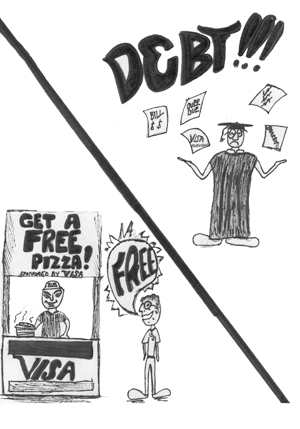 By DAVID MATTESON
By DAVID MATTESON
Debt. The word itself is scary, but the concept behind it is even more frightening.
Unfortunately for high school and college students, credit card debt is a likely possibility. A 2008 study by Sallie Mae concluded that 84 percent of college undergraduates possessed at least one credit card and the average balance for these students was $3,100.
With this figure in mind, Congress passed a ban on credit cards for anyone under 21 who could not supply proof of an income to make monthly payments or a cosigner who is at least 21. It also stops companies from distributing “free” incentives for signing up for a new credit card. This decision, which went into effect on Feb. 22, is justified and will hopefully help to prevent bleak futures for students.
Credit card recruitment on college campuses is a $13 billion industry according to financial authors Ali Kara, Erdener Kaynack and Orsay Kuckemiroglu. Beginning a credit history at such a young age means a greater number of years of interest.
Companies use advertising techniques that specifically appeal to college students. On campus they pass out free incentives, such as tee-shirts, food or other paraphernalia. These companies lure in young adults and trust they will build debt out of lack of financial knowledge, therefore benefitting the credit card companies.
The ban includes a clause that stipulates credit card companies must report any activity with universities, including payment for marketing agreements with the school. By doing so, Congress is helping to protect students from being lured in by these companies that spur life-changing effects.
In another study done by TrueCredit.com, four in ten college graduates leave school with approximately $5,000 in credit debt, and one in ten leave with $10,000 of debt. Not only do these debts prove tough to pay off, with increasing interest rates causing more of a burden, but they also set students up for a poor credit history. This will make purchasing a car or home in the future difficult.
When the time comes to apply for a credit card, young adults affected by this ban will understand and respect the importance of finances because of this law. This respect will hopefully prevent the doom of debt and a decline into bankruptcy.
According to the most recent information regarding bankruptcy, nearly 1.5 million Americans filed for bankruptcy in 2008, as reported by the Administrative Office of the Courts. Of this number, the largest demographic was between the ages of 35-44. By understanding the responsibilities of money and credit, young adults will be able to prevent bankruptcy when they are older.
Opponents to the ban argue that it prevents both irresponsible and responsible students from using a credit card. They feel this is not fair to those who are ready to use a card.
There are few students with the respect and real world experience needed to understand credit and finances. High school seniors are often first exposed to these concepts in a mandated economics class. However, this class is not enough to ready students for the real world concept of debt. Responsibility and understanding is gained through age and a stable income. By preventing young adults from applying for credit card until they are of age, students will be more likely to gain these qualities.
Congress’s decision to ban young adults from using credit cards is a responsible decision. It will surely prevent college grads from falling into the never-ending, frightening cycle of debt.